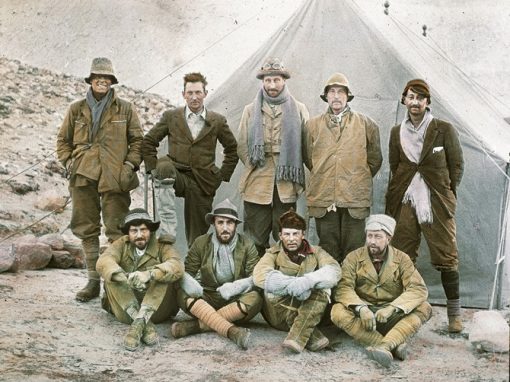
“To remain indifferent to the challenges we face is indefensible. If the goal is noble, whether or not it is realized within our lifetime is largely irrelevant. What we must do therefore is to strive and persevere and never give up.” ― Dalai Lama XIV
In March 1923 – 95 years ago this week – George Mallory was touring the USA to raise funds for his third attempt to summit Mount Everest, having failed in each of the two previous years. During his tour, he was routinely asked why he wanted to climb Everest. For Mallory, as an adventurer, this fell into the category of dumb questions, so he developed a standard answer: “Because it’s there.” He gave this now-famous answer again in New York, where the New York Times included it in the opening paragraph of its story on Mallory’s planned expedition. The article, “Climbing Mount Everest is Work for Supermen” (March 18, 1923), went on to provide Mallory’s explanation:
“Everest is the highest mountain in the world, and no man has reached its summit. Its existence is a challenge. The answer is instinctive, a part, I suppose, of man’s desire to conquer the universe.”
Mallory was right. The drive to overcome challenges is a part of human nature. Every age is filled with challenges: this is what fuels progress. Some of these challenges are new and daunting, while others are holdovers from times before our own; for although we overcome a great many, there are some for which we must pass the baton to another generation in the hope that we have equipped them to overcome a challenge we could not. But as George Mallory implied, within its very existence is a call for us to defeat each challenge we find.
Social, technological, and societal progress are all marked by the change wrought by challenges we have faced in the past. We might recall past challenges like the space race, the civil rights movement, or the antiwar protests of the 1960s. Already we can see social and societal challenges like these forming again all around us as reminders of ongoing challenges which are in grave need of fresh resolve: challenges for equality and justice.
Technological challenges before us today are like the wild science fiction of only a few decades past. And our perception turns out to be correct: the rate of change we are experiencing in these arenas actually is increasing – and doing so exponentially. We could view the number of challenges we face as increasing at the same pace, but so too does our capacity to meet them. Our age is characterized by an acceleration in discovery and achievement. In the information age, we’ve got better access to a greater accumulation of knowledge than has ever existed before, and we are presented with more opportunity than has ever been seen before.
With these advances, we create opportunity that brings with it new challenges that we haven’t fully grasped yet. Some of our biggest ones will involve dealing with the change that is all around us, from social change to climate change. Whether we saw these coming or not, we must acknowledge that a number of them are of our own making.
It’s a never-ending cycle. Change presents challenges, and challenges beget change.
Whether the challenge is physical, mental, social, or technical; whether personal, group, societal, or global challenges facing the whole of the human race, whether simple or complex, there are more than enough to go around. There are challenges of exploration or achievement, from world records in sport to exploring new arenas to technological achievements like green energy sources, faster microprocessors, or longer-lasting batteries for our mobile phones. A challenge may be as simple as learning to slow down and appreciate art or nature, or as complex as poverty or quantum mechanics. Sometimes the challenge is in seeing what needs to be challenged, and calling it out. Sometimes we’re the ones who need to be challenged — and sometimes we are the challenge.

Whatever it is, there may exist a challenge for each of us which by its very existence, as Everest’s did for George Mallory, offends something deep inside and sparks an urge to conquer it. George Mallory and his climbing partner Andrew Irvine were last seen less than 1,000 feet below the summit of Everest on June 8, 1924. Both men perished on the mountain, but it’s not hard to imagine that even knowing the outcome, they might still have made the attempt.
Our theme for TEDxWinnipeg 2018 is Challenge. Consider those that lay before you, and ask yourself what you will challenge, and how you will allow yourself to be challenged. What is your Everest?




